Electrical Safety Engineering of Renewable Energy Systems

Реклама. ООО «ЛитРес», ИНН: 7719571260.
Оглавление
Rodolfo Araneo. Electrical Safety Engineering of Renewable Energy Systems
Electrical Safety Engineering of Renewable Energy Systems
Contents
List of Illustrations
List of Tables
Guide
Pages
Preface
Acknowledgments
1 Fundamental Concepts of Electrical Safety Engineering
1.1 Introduction
1.2 Electric Shock
1.2.1 Ventricular Fibrillation
1.2.2 The Heart-current Factor
1.3 The Electrical Impedance of the Human Body
1.3.1 The Internal Resistance of the Human Body
1.4 Thermal Shock
1.5 Heated Surfaces of Electrical Equipment and Contact Burn Injuries
1.6 Ground-Potential and Ground-Resistance
1.6.1 Area of Influence of a Ground-electrode
1.7 Hemispherical Electrodes in Parallel
1.8 Hemispherical Electrodes in Series
1.9 Person’s Body Resistance-to-ground and Touch Voltages
Solution
1.10 Identification of Extraneous-Conductive-Parts
1.11 Measuring Touch Voltages
References
Notes
2 Safety-by-Design Approach in AC/DC Systems
2.1 Introduction
2.2 Class I PV Equipment
2.3 Class II PV Equipment
2.4 Ground Faults and Ground Fault Protection
2.5 Functionally Grounded PV Systems
2.6 Non-Ground-Referenced PV Systems
2.7 Ground-Referenced PV Systems
2.8 Fire Hazard in Ground-Referenced PV Systems
2.9 Faults at Loads Downstream the PV Inverter in Ground-referenced PV Systems
2.10 Non-Electrically Separated PV System
2.11 PV Systems Wiring Methods and Safety
2.12 d.c. Currents and Safety
2.13 Electrical Safety of PV Systems
2.14 Rapid-Shutdown of PV Arrays on Buildings
2.15 Hazard and Risk
References
Notes
3 Grounding and Bonding
3.1 Introduction
3.2 Basic Concepts of Grounding Systems:The Ground Rod
3.3 The Maxwell Method
3.4 Multiple Rods: Mutual Resistance
3.5 Ground Rings and Ground Grid
3.6 Complex Arrangements: Rings and Ground Grids Combined with Rods and Horizontal Electrodes
References
Notes
4 Lightning Protection Systems
4.1 Review of Natural Lightning Physics, Modeling and Protection
4.2 Lightning Protection of PV Systems
4.2.1 Ground-Mounted PV Systems
4.2.2 Rooftop Mounted PV Systems
4.2.3 Protection against Overvoltage
4.2.4 Surge Protective Devices (SPDs)
4.3 Lighting Protection of Wind Turbines
4.3.1 Lightning Protection System (LPS)
4.3.2 Step and Touch Voltages
4.3.3 Lightning Exposure Assessment
4.3.4 Assessment of the Average Annual Number of Dangerous Events NL Due to Flashes Directly to and near Service Cables
4.3.5 Lightning Protection Zones
4.4 High-Frequency Grounding Systems
4.4.1 Arrangement of Ground Electrodes
4.4.2 Effective Length of a Ground Electrode
4.4.3 Frequency-dependent Soil and Ionization
References
Notes
5 Renewable Energy System Protection and Coordination
5.1 Introduction
5.2 Power Collection Systems
5.3 Cable Connections
5.4 Offshore Wind Farm
5.5 Distributed Energy Resources: Battery Energy Storage Systems and Electric Vehicles
References
Notes
6 Soil Resistivity Measurements and Ground Resistance
6.1 Soil Resistivity Measurements
6.2 Wenner Method
6.3 Schlumberger Method
6.4 Multi-layer Soils
6.4.1 Ground Grid in Multi-layer Soil
6.4.2 Ground Rod in Multi-layer Soil
6.5 Fall-of-Potential Method for Ground Resistance Measurement
6.6 Slope Method for Grounding Resistance Measurement
6.7 Star-delta Method for Grounding Resistance Measurement
6.8 Four Potential Method for Grounding Resistance Measurement
6.9 Potentiometer Method for Grounding Resistance Measurement
References
Appendix 1 Performance of Grounding Systems in Transient Conditions
1 Grounding System Analysis
2 Mathematical Model
3 Computation of Impedances
4 Green’s Function
4.1 Static Formulation
4.1.1 One-Layer Ground
4.1.2 Two-Layer Ground
4.2 Dynamic Formulation
4.2.1 Equivalent Transmission Line Approach
5 Numerical Integration Aspects
5.1 Singular Term
5.2 Sommerfeld Integrals
References
Appendix 2 Cable Failures in Renewable Energy Systems
1 Cable Failures in Renewable Energy Systems: Introduction
2 Possible Solutions
2.1 Optimal Solutions
2.2 Termite Attacks Prevention
3 Non-destructive Methods for Cable Testing and Fault-locating
3.1 Insulation Resistance (IR) Test
3.1.1 IR Measurement of the Cable Insulation (XLPE)
3.1.2 IR Measurement of the Polyethylene (PE) Cable Jacket
3.2 High-Potential Test
3.3 LCR Test
3.3.1 Insulation Resistance (IR)
3.3.2 Dielectric Absorption Ratio (DAR)
3.3.3 Polarization Index (PI)
3.3.4 Quality Factor (Q)
3.3.5 Dissipation Factor (DF)
3.3.6 Time Domain Reflectometry (TDR) Test
3.3.7 Arc Reflection (ARC) Test
3.3.8 Bridge Methods
3.4 Cable Fault Analysis
3.4.1 Prelocation
3.4.2 Pinpointing
4 Sheath and Jacket Repairs
5 Termite Baiting Stations and Monitoring
6 Termite-proof Cables
Notes
Index
WILEY END USER LICENSE AGREEMENT
Отрывок из книги
Rodolfo Araneo
University of RomeRome, Italy
.....
Once the maximum operating temperature of readily accessible surfaces is determined, by direct measurement or calculation, the potential injury level may be established through the graph of Figure 1.7, which shows the relationship between surface temperature and exposure time.
Figure 1.7 Temperature–Time Relationship for burns.
.....